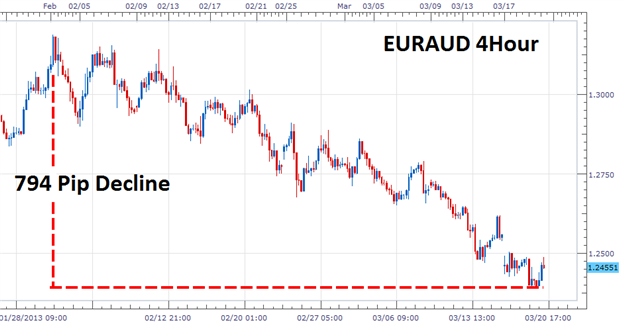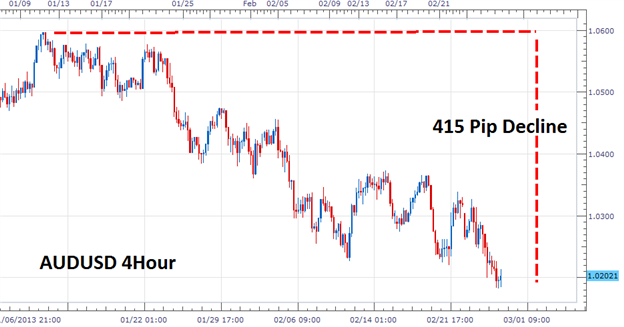ShortTerm Momentum Scalping in the Forex Market
Post on: 27 Сентябрь, 2015 No Comment

The Forex market moves fast very fast. This strategy can help traders focus on, and enter trades in the strongest short-term trends that may be available.
Many traders coming to the Forex market look to day-trade; and by day-trade, most of these traders are thinking of holding trades for a few minutes to a few hours at most.
The allure of such a strategy is understandable. By not holding positions overnight, the trader can feel an element of control that they may not feel otherwise. By always having a finger on the trigger, the trader can decide to add risk to the trade (to take advantage of the good movements), or take risk off (when the market isnt going your way).
The Finger-trap trading strategy was developed to attempt to take advantage of these situations, by focusing on the most important elements of what makes a strong trend a strong trend and those elements are generally strong, one-sided movement that can push our trades in our favor.
I call this strategy Finger-trap, because Im of the opinion that short-term trading in the currency markets are very much like the timeless childrens puzzle. In case you dont remember what finger-traps looked like, Ive added a picture below:
When a child first finds the finger-trap, they often insert their fingers only to find that that the bamboo weaving prevents them from being able to get out.
Its only with experience that one realizes that the trick to the finger-trap is to push, not pull. The key is to be relaxed, and feel your way to success; much like short-term trading.
The Trend Chart
Many traders are often puzzled by the shorter-term charts of less than an hourly bar size; and the reasons here are as understandable as the traders initial desire to scalp.
The reason these short-term charts can often be puzzling is because we are looking at so little information as compared to the longer-term charts, such as 1 day, or 1 week.
So before I ever attempt to scalp in a pair, I first attempt to locate the strongest trends that may be amenable for my efforts in the first place, and I will do this by analyzing the Hourly chart, attempting to find the strongest trends.
To do this, I use 2 Exponential Moving Averages: The 8, and the 34 period EMA. Below you will see the trend chart with the 2 Moving Averages added.
Created with Marketscope/Trading Station
Many traders using 2 moving averages will look to trade crossovers. And sure, some of those crossovers may have worked out ok on this chart above, but over the long-term, Ive personally found such a strategy to be undesirable; particularly when trending markets change to ranges, consolidation, or congestion which they will inevitably do.
So I instead focus on stronger elements to constitute a trend; and I want to focus my efforts to the strongest portions of these trends. I will do this by noticing the location of the moving averages; and looking for price agreement before moving on to place entries.
So, if the Fast Moving Average (8 period) is above the Slow Moving Average (34 period), I want to see price above both. The chart below will illustrate this concept.
Created with Marketscope/Trading Station
In the case of bear markets, were looking for something similarly reversed.
If the Fast Moving Average is below the Slow Moving Average, I only want to move down to the entry chart when price is below both. The chart below will illustrate further:
Created with Marketscope/Trading Station
Once this criterion is met, I feel comfortable enough to move down to the short-term chart to enter into the trade.
The Entry Chart
While many scalpers want to jump on a five or 15 minute chart and just get started, Im of the belief that not nearly enough information is available there to make an accurate determination of a currency pairs trend, support and resistance, or a flurry of other factors that I want to know before putting my hard-earned money at risk on a trade; and this is why I do the bulk of my technical analysis on the hourly chart.
Once Im comfortable with that hourly chart, and have a good idea that I might be able to work with a strong trend, Ill dial down to the five-minute chart.
And with this 5 minute chart Ill attempt to employ the age-old principal of buying-low, and selling-high. This means that I want to see a short-term cheapening of price during bullish up-trends; or a short-term movement of price getting more expensive in downtrends.
When the trend-side momentum comes back in the pair I will look to enter my trade.
To attempt to gauge whether the pair is cheap in the short-term, I will, again, draw on the 8 period Moving Average.
On the 5-minute chart, I want to see price move against the moving average (against the trend that I had observed on the one hour chart), so that price may re-load before advancing further.
The chart below will illustrate what Im looking for during a bullish up-trend, when I had seen price above both the fast and slow moving average on the hourly chart.
Created with Marketscope/Trading Station
Notice that not every one of these candles/entries would have preceded a run in the currency pair.
It is absolutely possible for a currency pair to congest/consolidate over an extended period of time before making a move up or down. Traders can handle these situations through lot sizing.
For instance, I can take a stance of looking to enter up to 5 positions. So, for each of the first 5 crosses of the 8 period EMA, I continue to add to my lot.
Or perhaps, I can look to only take the first, place my stop, and wait for the trade to either move in my direction or hit my stop.
This is where much customization can be made with the strategy.

In the case of short positions, we are looking for exactly the opposite occurrence than we had looked at a moment ago.
After weve seen that the 8 period EMA is below the 34; and price is trading below both Moving Averages, indicating to me that the trend is clean, strong, and one-sided moving further lower I will look to open short positions on the 5-minute chart, and I will do this with the 8 period EMA.
Created with Marketscope/Trading Station
Each time price crosses below the 8 period EMA, I have another opportunity to open up a short position.
If you notice the right side of the above chart, you may see that price begins to find support on the 8 period moving average indicating that we may have a reversal of trend; and that brings us to one of the most beneficial parts of the Finger-Trap trading strategy: Risk Management.
Managing Risk
If we are placing trades on the 5 minute chart, and looking to only take part in strong moves in the direction of the trend we had identified on the hourly chart; we have quite a bit of flexibility in how we want to consider risk.
In the article Price Action Swings. we had identified a mannerism of capping risk when trading trends.
When placing a long trade, I want to ensure that price remains supported for the duration of my trade. If short-term support is broken, I run the risk of the pair continuing to move against me, further draining my account. To a scalper, this can be extremely dangerous as fast markets can exhaust an account balance very quickly.
By placing my stop at the previous swing-low, I can strike the happy medium of being comfortable with giving the trade some wiggle room, to work into profit, while at the same time, allowing myself to exit quickly if the trend reverses.
While price may break support, and come back in my favor Im much more worried about the instances when that doesnt happen. So this swing low (on long positions, swing high on short positions) often functions as my line in the sand in the event the position moves against me.
Created with Marketscope/Trading Station
Once again, in the event of short positions, we would be looking at the opposite scenario; looking to place stops just outside of the recent swing-high so that if price reverses the down-trend that we were looking to take part in, we may cut the loss early.
Created with Marketscope/Trading Station
— Written by James B. Stanley
To contact James Stanley, please email Instructor@DailyFX.Com. You can follow James on Twitter @JStanleyFX.
To join James Stanleys distribution list, please click here.














